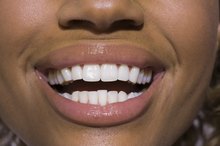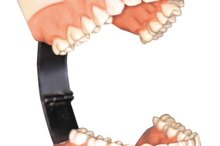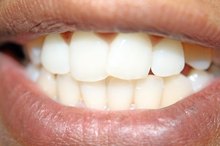How to Set Up for a Dental Composite Procedure
Dental composite fillings are becoming more widely accepted by both dentists and patients than traditional amalgam (silver) fillings. That’s because composite resins match the natural tooth color in addition to being able to bond directly to teeth. Composite resins typically have been placed in the front teeth for aesthetic reasons. However, the makeup of composite resins continues to improve, allowing them to be strong enough to be placed in the back teeth as well, according to Torres and Ehrlich, "Modern Dental Assisting. 1”
Tray Setup for Composite Filling Procedure
Place the topical anesthetic and cotton tip applicator on the dental tray, along with a local anesthetic syringe with a disposable needle and carpule for numbing the patient. Organize the rubber dam, punch, frame, clamp, forceps, scissors and floss on the tray (the rubber dam isolates the tooth or teeth being worked on for infection control and increased efficiency).
How to Make Your Own Tooth Caps
Learn More
Obtain a shade guide to match the color of the composite resin material to the tooth/teeth being worked on. Place varying shades of the composite resin on the dental tray along with a single-paste lightproof syringe and light-curing gun to harden the resin material.
Place the mirror, explorer and cotton pliers on the dental tray (the basic tray setup for any dental procedure). Gather the excavators and other hand cutting instruments (such as a hoe or chisel), which remove the decay from the tooth/teeth being filled and smooth the cavity walls and floors of the preparation(s).
Dental Terminology Abbreviations
Learn More
If required, place a matrix band and wedge on the dental tray, along with Howe (#110) pliers for placing the wedge (the matrix band creates a temporary wall against which the composite resin can be placed, and the wedge positions the matrix band firmly). In addition, place 2-inch-by-2-inch alcohol gauze pads on the dental tray.
Obtain the base, liner, primer, etchant and bonding materials and place on the dental tray. The liner and base protect the pulp of the tooth (the part that contains the nerves and blood vessels), while the primer is a sealer that prevents hypersensitivity from the restoration. The etchant removes a thin layer of debris from the tooth in preparation for bonding, which restores protection to the tooth.
Retrieve the finishing burs or diamonds for the high-speed handpiece, which is used to finish the composite resin restoration. Also, place medium disks and superfine disks for polishing the resin on the dental tray, along with finishing strips for polishing spaces between teeth. Place a polishing paste and rubber cup on the tray.
Place articulating paper and its holder on the dental tray. The paper is used to check the patient’s bite once the composite resin restoration is in place.
Tips
Have a patient bib and chain ready for the patient, as well as goggles to protect the patient’s eyes during the procedure. Also, have gloves and a mask ready to place on before beginning to assist the dentist with the procedure to prevent the spread of infection.
Warnings
Have a surface disinfectant, towels and clean barriers available for cleaning up the room following the procedure.This prevents the potential spread of disease from one patient to another.
- Place the topical anesthetic and cotton tip applicator on the dental tray, along with a local anesthetic syringe with a disposable needle and carpule for numbing the patient.
- Place the mirror, explorer and cotton pliers on the dental tray (the basic tray setup for any dental procedure).
Related Articles
References
- "Torres and Ehrlich Modern Dental Assisting;" Doni L. Bird, MA, and Debbie S. Robinson, MS; 2009
Tips
- Have a patient bib and chain ready for the patient, as well as goggles to protect the patient’s eyes during the procedure. Also, have gloves and a mask ready to place on before beginning to assist the dentist with the procedure to prevent the spread of infection.
Warnings
- Have a surface disinfectant, towels and clean barriers available for cleaning up the room following the procedure.This prevents the potential spread of disease from one patient to another.
Writer Bio
YaShekia King, of Indianapolis, began writing professionally in 2003. Her work has appeared in several publications including the "South Bend Tribune" and "Clouds Across the Stars," an international book. She also is a licensed Realtor and clinical certified dental assistant. King holds a bachelor's degree in journalism from Ball State University.









